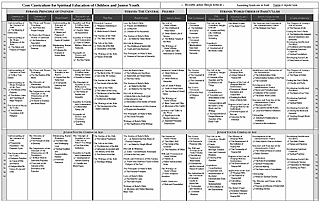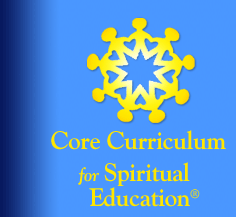Scope and Sequence
Scope and Sequence
Scope and Sequence of Spiritual Education
Purpose

The Core Curriculum Scope and Sequence is designed to assist teachers and communities in planning curriculum for Bahá’í classes and creates an integrated sequential program for nine years of instruction. The Scope and Sequence Chart is presented in a large grid format.
Please view and print the chart.
This document:
Assists Local Spiritual Assemblies and Education Committees in providing guidance for structuring a systematic spiritual education program
Provides teachers with a tool for sequencing curricular units of study in Bahá’í education (Teacher's Spiritual Education Plan)
Keeps parents informed through a feedback tool that shows what a child or youth has studied or will study (Student’s Spiritual Education Record)
Ensures consistency in quality and content of spiritual educational program throughout the Bahá’í community
Ensures that children and youth maintain a consistent spiritual education program after moving from one community to another
Enables new children and youth to be easily incorporated into a systematic Bahá’í educational program
This sequential approach presents a well-balanced division of all available topics of study. Criteria for this division includes diversity of topics and average capacities and capabilities of learners. The Core Curriculum Scope and Sequence has been designed with three levels to sequence the topics to be learned.
In a community where the majority of core curriculum learners are children, the following age range is suggested for each level:
Level One — for children 6-8
Level Two — for children 9-11
Level Three — for junior youth 12-14
The levels can also apply to an individual’s general knowledge and understanding as well as to chronological age. For instance, level one is applicable to a new student of any age.
Level One — introductory for all ages
Level Two — intermediate for all ages
Level Three — advanced for all ages
The objectives of the Lesson Planning Guides are therefore ageless and apply equally to adults and children; this is accomplished by wisely adjusting or selecting age-appropriate activities to match each learning objective.
Structure
The Core Curriculum organizes spiritual education curriculum content into strands, or major categories of study, such as the Central Figures, the World Order of Bahá’u’lláh, and The Principle of Oneness.
Strands, themes, goals, and topics are explained on pages iii-v and 1-2 of the Lesson Planning Guides.
Rows: The Scope and Sequence is structured so that going across the page from left to right the contents of the curriculum for all strands and themes in each level are listed in rows.
Columns: Going down the table, the contents of each strand and theme are presented in columns through advancing levels.
Goals: Learning Goals are listed in bold type.
Topics: Topics within each goal are listed in regular type.
Every topic of the curriculum is placed in this table; thus a student who completes a course of study that is designed by using the Scope and Sequence will have been introduced to every topic of the entire curriculum. This table thus allows a community to plan their whole curriculum at a glance, to see where they have been and where they are going.
Planning Goals and Topics
As the level of the content increases, the level of content knowledge also increases. For example, under the booklet The Báb, the goal of "Historical Context" appears in both level one and level two. The level one material is at a beginner level. The topics of that goal covered under level one are different from those covered under more advanced levels. The topics of that goal under level two are more of an intermediate level. Here is a list that will show you the gradual advance in content between levels:
Central Figures: Bahá’u’lláh — Level One
Goal: Love for Bahá’u’lláh
Topic: Prayers and Meditations
Topic: Loving Acts
Topic: Children of His Household
Goal: The Station of Bahá’u’lláh
Topic: The Station of Bahá’u’lláh as Stated by ‘Abdu’l-Bahá
Goal: His Life and Ministry
Topic: The Childhood of Bahá’u’lláh
Topic: Youth and Early Manhood
Goal: The Principles of Bahá’u’lláh
Topic: Oneness of God and of Humanity
Notice that in Level One there are four learning goals, each has one or more topics of study. In Level Two we see the same four learning goals, and the topics are different and more advanced. Two new learning goals are also added.
Central Figures: Bahá’u’lláh — Level Two
Goal: Love for Bahá’u’lláh
Topic: The Suffering and Sacrifices
Topic: Bahá’u’lláh and ‘Abdu’l-Bahá
Topic: The Holy Family
Goal: The Station of Bahá’u’lláh
Topic: The Station of Bahá’u’lláh as Stated by the Báb
Topic: The Station of Bahá’u’lláh as Stated by His Own Pen
Goal: His Life and Ministry
Topic: Bahá’u’lláh in the Síyáh-Chál
Topic: Banishment to Iraq
Topic: Declaration in the Garden of Ridván
Goal: Proofs & Evidences of His Station
Topic: Progressive Revelation
Goal: The Principles of Bahá’u’lláh
Topic: Social Principles
Goal: The Writings of Bahá’u’lláh
Topic: The Significance of the Writings
In Level Three we see four of the same learning goals as Level Two, again with different and more advanced topics. One introductory learning goal is no longer included, and two more advanced goals are added.
Central Figures: Bahá’u’lláh — Level Three
Goal: Love for Bahá’u’lláh
Topic: The Suffering and Sacrifices
Topic: Bahá’u’lláh and ‘Abdu’l-Bahá
Topic: The Holy Family
Goal: The Station of Bahá’u’lláh
Topic: The Station of Bahá’u’lláh as Stated in the Holy Books of Previous Religions
Topic: The Station of Bahá’u’lláh as Stated by Shoghi Effendi
Goal: His Life and Ministry
Topic: Exiles to Constantinople and Adrianople
Topic: Exile to the Holy Land
Goal: Proofs & Evidences of His Station
Topic: Proofs & Evidences Found in Divine Religions of the Past
Goal: The Principles of Bahá’u’lláh
Topic: Personal Principlesy
Goal: Laws of Bahá’u’lláh
Topic: The Need for Laws
Topic: The Kitáb-i-Aqdas
Goal: The Writings of Bahá’u’lláh
Topic: Mysteries and Hidden Meanings
Topic: Major texts
In this manner the learning goals advance between levels. The topics within them become more complex with each level. Thus children of advancing age and grade levels will have material appropriate to their capacity to understand. Likewise people of all ages may pursue the learning goals and topics appropriate to their gradual advancement in knowledge of the faith.
The lessons plans provide material on every topic suitable to a wide age range of learners. There is material on each topic suitable for beginning readers, and also for those reading at a middle school or more advanced level as well.
The storybooks have chapters matched with every topic. In each chapter there are stories for several different reading levels. Thus many people of various ages and capacities can use these materials in a manner appropriate for their knowledge level and interest. The flexibility of this comprehensive system can be applied to a varied range of community situations. These are illustrated in the examples of implementation below.
Examples of Implementation
The following three examples illustrate the many different environments in which this tool can be used.
Example 1: Community A
Community A, a small but growing community begins their classes with 14 children, organizes classes by age, and plans Level One class content for ages 6–8; Level Two for ages 9–11; and Level Three for ages 12–14. Two teachers are assigned to each age group. They determine how to divide the topics in their Level over a three-year span, ensuring that by the end of three years all of the topics in their Level will be addressed.
Example 2: Community B
Community B, a larger community with 57 children at the beginning of the year, also organizes classes by age, and uses class content Level One for ages 6–8; Level Two for ages 9–11; and Level Three for ages 12–14. However, they have different classes for each age. A school committee has divided the topics of each level into 3 years of study. For instance, they noted that there are 27 topics in Level One, so 9 topics have been assigned to the 6-year-old class; 9 topics to the 7-year-old class; and 9 topics to the 8-year-old class.
Example 3: Community C
Community C, a Bahá’í community totaling 23 members, plans 3 multi-age classes. Each class studies the same strand, but one class covers Level One topics, another class covers Level Two topics and a third class covers Level Three topics. Thus the entire community may study the Báb in the spring of the year; Bahá’u’lláh in the summer; ‘Abdu’l-Bahá in the fall; and Oneness of Humanity during the winter. Since each class will cover only a few topics of their Level in each strand, the cycle will repeat with new topics for the Báb in the spring of the following year; new topics for Bahá’u’lláh in the summer; new topics for ‘Abdu’l-Bahá in the fall; and a study of The Covenant during winter.
Embracing a Rapid Cycle of Growth – As more and more individuals and families become attracted to the regenerating Teachings of Bahá’u’lláh, Bahá’í schools of all sizes must be ready to welcome these individuals with open arms. The example communities above illustrate different methods for integrating new members into existing Bahá’í classes.
In both examples 1 and 2, which divide classes by age, various solutions can be employed to ensure that students newly placed in classes can still learn topics their classmates have previously explored in previous classes. For example, a 10-year-old child of a new Bahá’í family will need to learn content elements of Level One, although the child enters a Level Two class. It is important, for instance, that every Bahá’í child study the Level One topic, “Prayers and Meditations of Bahá’u’lláh.” Community A has appointed a youth mentor to work weekly with this new Bahá’í outside of class. Community B has a formal home-study program and an adult home-study teacher to serve entering children. In example 3, the 10-year-old child of a new Bahá’í family is easily integrated into the multi-age Level One class along with other family members.


